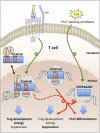Alternative Splicing of FOXP3-Virtue and Vice
- PMID: 29593749
- PMCID: PMC5859138
- DOI: 10.3389/fimmu.2018.00530
Alternative Splicing of FOXP3-Virtue and Vice
Abstract
FOXP3 is the lineage-defining transcription factor of CD4+ CD25+ regulatory T cells. While many aspects of its regulation, interaction, and function are conserved among species, alternatively spliced FOXP3 isoforms are expressed only in human cells. This review summarizes current knowledge about alternative splicing of FOXP3 and the specific functions of FOXP3 isoforms in health and disease. Future perspectives in research and the therapeutic potential of manipulating alternative splicing of FOXP3 are discussed.
Keywords: FOXP3; FOXP3Δ2; FOXP3Δ2Δ7; Th17 cells; Treg cells; alternative splicing; antisense oligonucleotides; isoform.
Figures


References
Publication types
MeSH terms
Substances
LinkOut - more resources
Full Text Sources
Other Literature Sources
Research Materials

